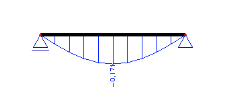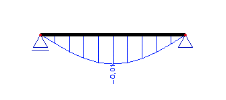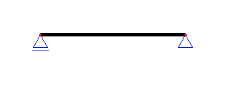Deformation from load case
Quite often it may happen that some of the loads are acting on a structure before any other load is imposed. In addition, it is possible that this initial load leads to significant imperfections that may considerably affect the static behaviour of the structure.
A typical example is a rope structure, i.e. a structure whose parts are suspended on ropes or cables. Just the self-weight may cause a significant deflection of these ropes or cables. Also slender steel beams are a good example.
Example
Let’s consider a simply supported beam subject to two horizontal forces that compress the beam.
Let’s assume that the beam is slender and that just the weight of the material would cause a significant deflection. The first calculation is therefore made for "self-weight load case" only. Its results are shown below.
The obtained result (for the self-weight) can be then selected in the Non-linear combination manager as the source of the initial imperfection.
The final non-linear calculation then gives results taking account of the pre-deformation.
If the initial imperfection had not been taken into account at all in our sample structure, the results would have been completely different. The beam, ideally straight and subject to axial load only, would show no deformation perpendicular to the longitudinal axis.
Usually (but not exclusively), a static linear calculation is sufficient enough for the determination of the initial imperfection due to a specific load case. Subsequent calculation whose aim is to take account of the initial imperfection, however, must already be a non-linear one.
The calculated and displayed deformation is ALWAYS measured from the imperfect model, i.e. it does not represent the total deformation from the ideal shape, but the overall deformation from the imperfect shape.





